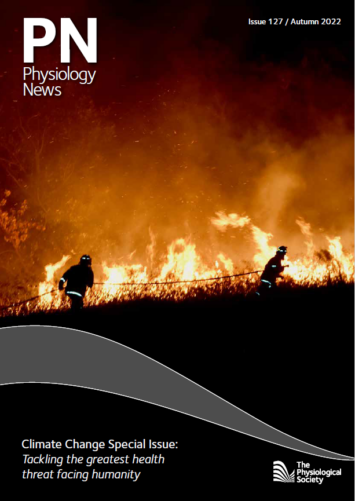
Physiology News Magazine
President’s View
The heart of our new strategy: Building a strong community of physiologists to advance science
News and Views
President’s View
The heart of our new strategy: Building a strong community of physiologists to advance science
News and Views

https://doi.org/10.36866/pn.127.6
Professor David Paterson
President, The Physiological Society
Almost 150 years ago, on 31 March 1876, 19 men who had made – or would make – significant contributions to physiological research, teaching or writing met at John Burdon Sanderson’s house in London. They discussed a Royal Commission, which had been established on the practice of subjecting live animals to experiments for scientific purposes and a proposal to form an association for ‘promoting the advancement of physiology and facilitating the intercourse of physiologists’.
Within a few weeks, rules for such an association were agreed and an inaugural dinner was held at Criterion restaurant in Piccadilly. The Physiological Society was formed.
The Society’s Minute Book from the time contains a list of Sanderson’s guests – founders, with him, of The Physiological Society. Their names appear as follows: Wm. Sharpey, Tho. H Huxley, Michael Foster, Geo. H Lewes, Francis Galton, John Marshal [sic], G.M. Humphry, Fk. Wm. Pavy, T. Lauder Brunton, David Ferrier, P.H. Pye-Smith, Wm. H. Gaskell, J.G. McKendrick, E. Klein, E.A. Schafer, Francis Darwin, Geo. J. Romanes and Gerald F. Yeo.
It is in the footsteps of these greats from our past that current members of The Society walk. While the world of 2022 looks very different to that of 1876, our core purpose as a community of physiologists who work together to support each other and advance the physiological sciences remains unchanged. Our members truly are our greatest strength. The aspect of my presidency I have enjoyed the most is meeting members and hearing their passion for physiology and The Society.
While as an organisation we have never stood still, the pace of change in the world around us is now greater than ever and demands a step change in how we operate to meet the challenges we will face.
It is for that reason that The Society has spent the last few months developing its new strategy to run from 2023. It is an ambitious strategy that builds on our successes, addresses challenges, and sets us on a course to grow stronger in the future.
We have seen over recent years the real success of reinvigorated engagement within institutions, and through schemes like our Blue Plaques and Member Roadshows are now regularly travelling across the UK and Ireland to meet with members. Our policy work has focused on making the case to decision-makers and funders on the role of physiology in tackling societal problems such as healthy ageing and climate change.
There are plenty of challenges ahead. Open Access, through Plan S, will transform the publishing environment and require us to change our approach. Greater competition for members means we must ensure we are offering our membership the support and services they need. Increasing scientific subspecialisation means we must continue to make the case for discipline relevance. Pressures on higher education institutions will demand we are agile and vocal in advocating for our members’ interests within departments.
As the Chief Executive of UK Research and Innovation, Professor Ottoline Leyser, has stated, our current research system is too siloed, which “restricts career paths across roles, sectors and disciplines, reinforcing silos by reducing connectivity and the flow of people and ideas.” In response, The Society must consider how to connect the broader scientific ecosystem by reaching out beyond academia into industry and clinical settings to support the full breadth of physiology.
This includes ensuring we are supporting our excellent physiology educators, who are working to inspire the next generation of physiologists, medics, healthcare scientists and many others.
Our journals are recognised as world leading with international reach, and our new strategy will improve the connections between them and our membership. The Society has huge breadth and depth across areas of the discipline, institutions, sectors, and countries. With over 60 countries represented in our membership, we are truly a global community. Many of the challenges facing physiologists are shared the world over, and a stronger global network will support physiology to thrive.
Physiologists building their career will continue to be time pressured and at the heart of The Society’s mission should be that our conferences are viewed as “must not miss” events and our support and publications are essential to career and scientific advancement.
I am proud that we have had 60 Nobel Prize winners among our membership: we must ensure we are supporting the Nobel Prizewinning physiologists of tomorrow.
To achieve this, our new strategy will be focused on five overarching objectives that we will measure our delivery against, underpinned by The Society’s Equity, Diversity, and Inclusion Roadmap.
By the end of 2027 we will:
- Have a larger, more engaged, and more diverse community of members.
- Be essential to physiologists building their career.
- Improve our relevance by strengthening our links at key interfaces of physiology and between sectors.
- Play an influential role in shaping funding and public policy.
- Be a forward-looking, sustainable society.
For almost 150 years we have been at the forefront of life sciences, but we must never assume our future position is guaranteed. As a discipline and as an organisation, we must be clear in our mission and adapt in order to achieve it. Being proud of our history and heritage while looking clearly to the future is at the core of our new strategy, and how we will work with our members, partners and the public to build a strong community of physiologists to advance science.
The Society’s new strategy will be launched at our Member Forum on Friday 2 December at the Royal Society in London. All members are invited to attend. https://www.physoc.org/events/member-forum-2022/
